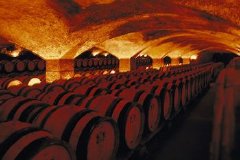After analysing different points of the process of the transformation of grape juice to wine, Ms Ana González Marco concluded that the type of container (wooden cask or steel tank) employed notably influences the fermentative aroma of Chardonnay wine, and that oak cask-fermented wines have, in general, a greater concentration of superior alcohols and esters of medium-sized chains of fatty acids.

Her thesis had two fundamental objectives: to study the formation of volatile compounds of Chardonnay wines, fermented using a number of different methods, and to determine the amine content of the wine and its evolution during the conservation of the product.
As Ms González explains in her research work, in the agricultural food industry and, in particular, in the oenological sphere, the quality of the product is increasingly important and thus the factors influencing this quality. In wine-making the ageing and fermentation techniques used affect the aroma, a highly important factor in its quality. The aroma is the result of the interaction of the volatile compounds with the taste and olfactory senses, Ms Gonzalez explains. The volatile compounds are responsible for the aroma(s), while the non-volatile ones, such as sugars, organic acids and mineral substances give rise to the sensations on the palate of sweetness, acidity, bitterness and saltiness.
The aroma of wine is made up of a balance of more than 800 volatile compounds, most of which form during the process of fermentation in which the sugars in the grape transform into ethanol and carbon dioxide. The fermentative-origin volatile compounds make up the most important part of the aroma of the wine and, in white wines, this part of the aroma is fundamental, given that wines that are drunk young are not, in general, matured. Nevertheless, certain wines from high-quality white grape varieties, such as Chardonnay and Sauvignon blanc, are used in the production of fermented white wines which are subsequently aged in wooden barrels.
The use of oak in the fermentation of dry white wines of quality has been a practice employed for a long time and shown to be of influence in the volatile composition of wine: in general, the aroma of cask-fermented white wines is less pronounced than in those fermented in stainless steel vats and then transferred to the barrel for ageing. The olfactory impact of certain volatile substances extracted from the wood is limited by the action of yeasts during fermentation, as this activity transforms these substances into other types of derived compounds.
The demand for more hygienic production practices has made the use of stainless steel vats more widespread for the making of all kinds of wines, amongst these being Chardonnay whites.
Ageing of white wines
Another of the aspects relating to the quality of wine, and in which a lot of emphasis has been placed in recent years, is the presence of biogenic amines in wine. These are nitrogenated compounds which mainly form during the alcoholic and malolactic fermentations of the wine, although they can continue to evolve during the period of ageing. Their importance is due to the fact that they may have negative effects on human health, as the consumption of wine with high concentrations of biogenic amines, especially histamine and tiramine, and can produce cephaleas, allergic reactions, palpitations, hypertension, diarrhoeas, and so on. In fact, in countries such as Switzerland the levels of histamine in wines for export are controlled.
Another of the conclusions of Ms González was that Chardonnay wines subjected to weekly agitation during ageing in the barrel had greater histamine and tiramine content than those wines aged in an undisturbed manner. Also, after 105 days of conservation of Chardonnay wine in the bottle, the total concentration of the wine amines goes up. This increase is mainly produced during the first 45 days of conservation; however, the temperature of conservation did not have an influence on the concentration of these substances in the wine.